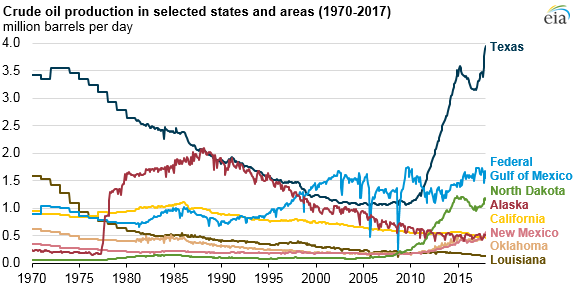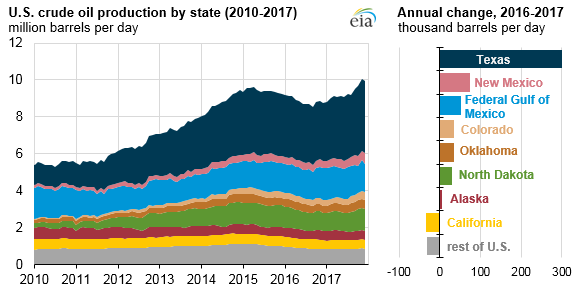U.S. production of crude oil grew 5% in 2017, likely leading to record 2018 production
Annual average U.S. crude oil production reached 9.3 MMbpd in 2017, an increase of 464 Mbpd from 2016 levels after declining by 551 Mbpd in 2016. In November 2017, monthly U.S. crude oil production reached 10.07 MMbpd, the highest monthly level of crude oil production in U.S. history. U.S. crude oil production has increased significantly over the past 10 years. EIA projects that U.S. crude oil production will continue to grow in 2018 and 2019, averaging 10.7 MMbpd and 11.3 MMbpd, respectively.

Note: EIA’s State Energy Data System has annual values for crude oil production for 1970 through 1980.
Although much has changed since 1970, Texas continues to produce more crude oil than any other state or region of the United States. Texas has held the top position in nearly every year since 1970, with the exceptions of 1988, when Alaska produced more crude oil than Texas, and from 1999 through 2011, when production from the Federal Gulf of Mexico was higher.
Texas crude oil production averaged 3.5 million b/d in 2017 and reached a record high monthly level of 3.95 million b/d in December 2017. Texas’s 2017 annual production increase of nearly 300,000 b/d—driven by significant growth within the Permian region—was more than all other states and the Federal Gulf of Mexico combined.

Growth in the Permian region, which spans parts of Texas and New Mexico, also contributed to a 74,000 b/d production increase in New Mexico, the state with the second-largest growth in 2017. New Mexico surpassed California and Alaska to become the third-largest crude oil-producing state in the second half of 2017, although it produced less than those states on an annual average basis.
In the Federal Gulf of Mexico, new projects and expansions that started in 2016 ramped up production in 2017, which, along with two other projects that began in 2017, contributed to 51,000 b/d of annual growth to reach the highest annual average crude oil production from the Federal Gulf of Mexico. The Federal Gulf of Mexico was the second-largest producing region in 2017.
Production levels in Colorado, Oklahoma, and North Dakota each grew by more than 30,000 b/d from 2016 to 2017, while Alaskan production increased only slightly. California’s production declined 34,000 b/d, the state’s third consecutive annual decline.






Comments